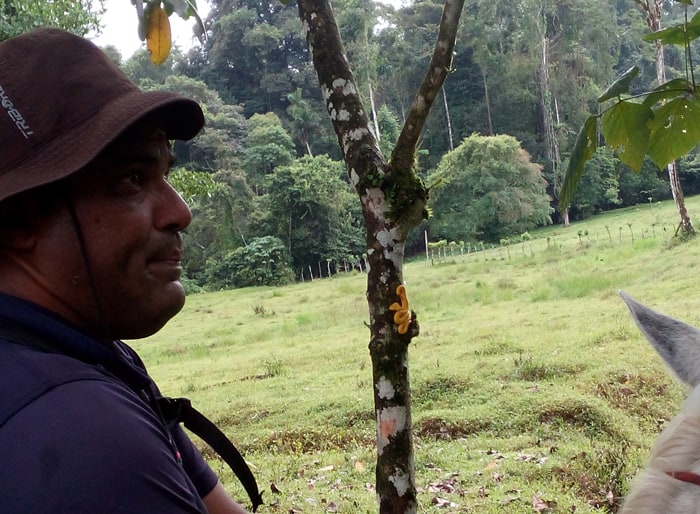BANANITO, Limón — After a very rainy Christmas Day drive from San José to the Caribbean Sea, and after some bad directions from both the Waze app and a woman on her porch, I finally got on the right road to Selva Bananito Lodge, and it was a doozy.
Some of the mud puddles were more like mini-lagoons, and more than once I envisioned myself getting stuck in one of them, if not tumbling sideways into the ditch while trying to drive around them.
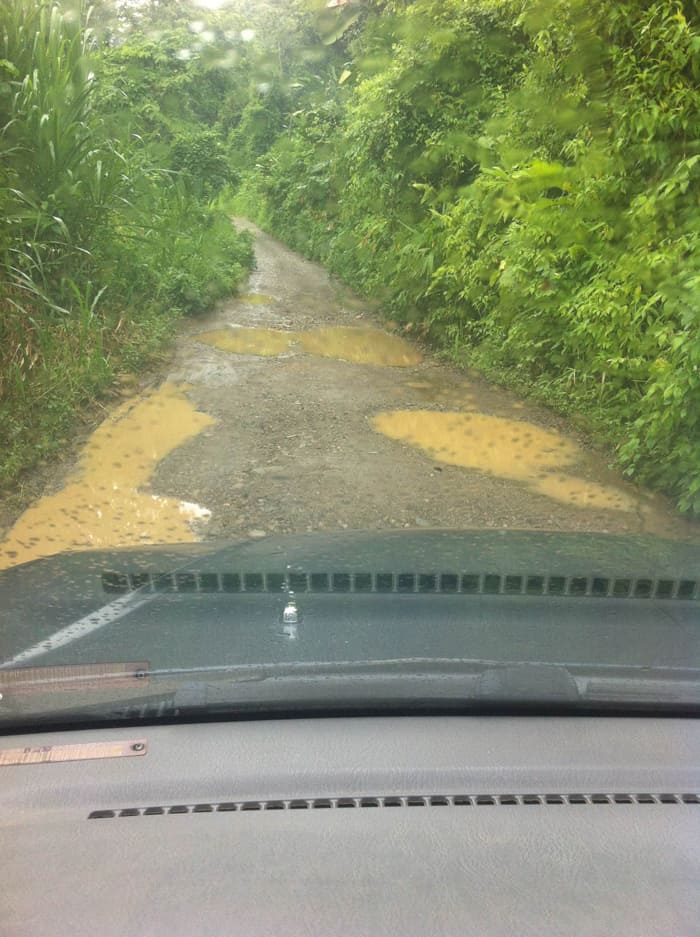
Another vehicle approached from the other direction, and I wondered how we would get past each other. It pulled over next to one of those puddle-lagoons and flashed its lights, inviting me to drive right through one of the deep places I was trying to avoid.
My Blue Demon powered through the water, but imagine my surprise when I passed the other driver and heard him shout, “Karl!”
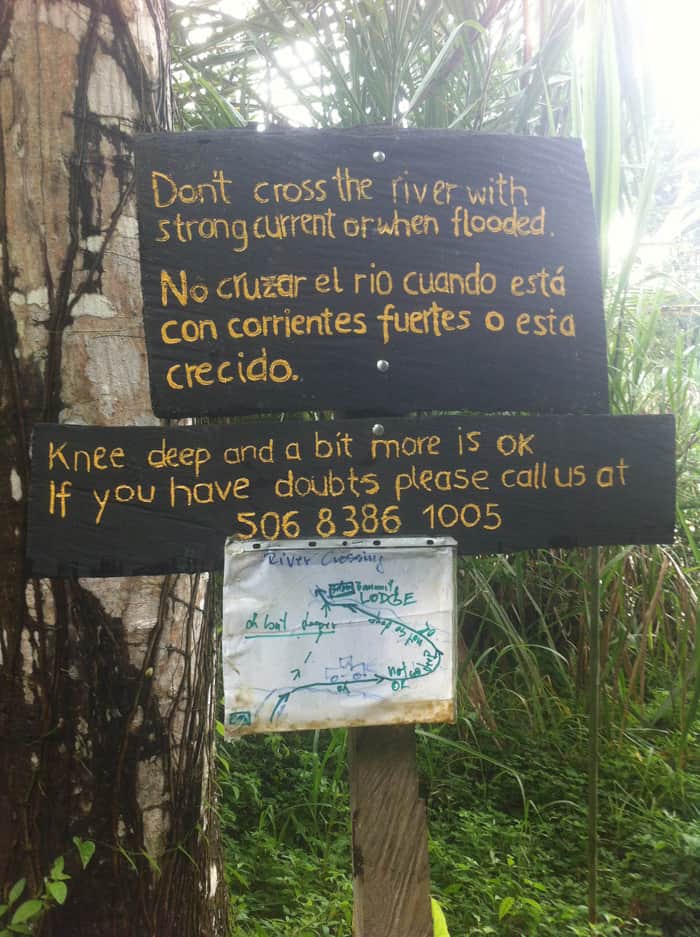
It was Jürgen Stein, the proprietor of Selva Bananito, who had invited me to come for the 20th anniversary of the lodge, which would be celebrated with special presentations on all the things this little hotel was doing to save the planet.
Jürgen said he was headed into town to pick up another guest but told me to keep going and just follow the signs. His directions had warned of a river that should not be crossed if flooded, and he asked if my four-wheel drive was working OK. I said it was, and he said I should be fine — just head to the right, following the current, and swing around.
“It’s shallow,” he said, “you’ll see.” He said he’d be there in about an hour.
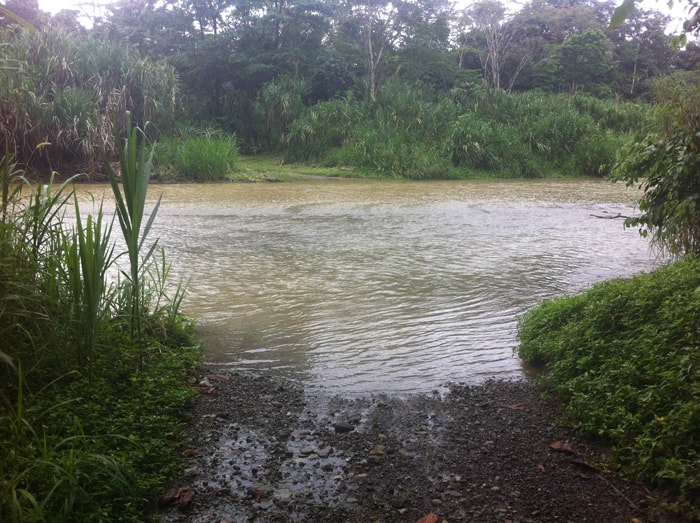
But when I came to the Río Bananito, I gaped. It was wide and fast and looked plenty deep. I parked and got out to look, finding a sign with a homemade drawing that showed the best way across — a wide detour to the right. I wouldn’t have thought it possible.
I decided to change out of my long pants and shoes and put on shorts and flip-flops to try crossing the river on foot. And I did find a knee-deep passage, which should have been drivable.
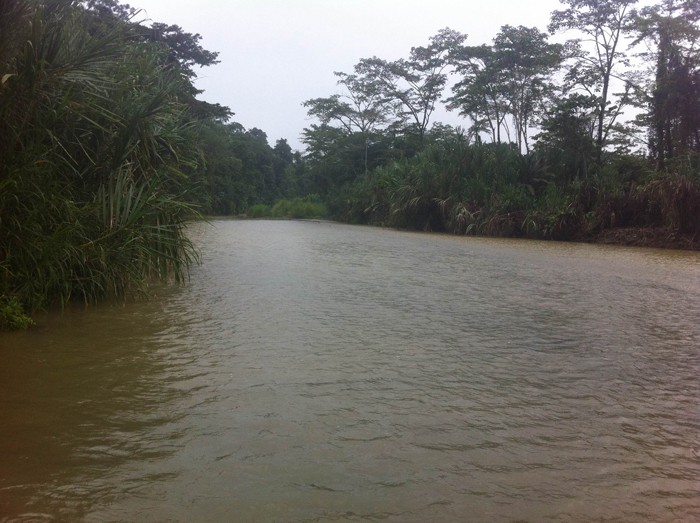
But I couldn’t shake the picture in my mind of getting stuck in the river, and I decided that what made the most sense was to wait for Jürgen to get back and follow him across. Between my slow driving, changing of clothes and fretting over the river, close to an hour had passed anyway.
Sure enough, before long Jürgen pulled up and gave me a proper greeting, with an enthusiastic handclasp, a hug, a “Feliz Navidad,” a “Pura vida” and a “Buena nota.” He introduced me to his guest, a German named Anette who is part of an organization that recruits volunteers for places in Costa Rica like this one.
And then he told me to park my car and jump in with him. So I did.
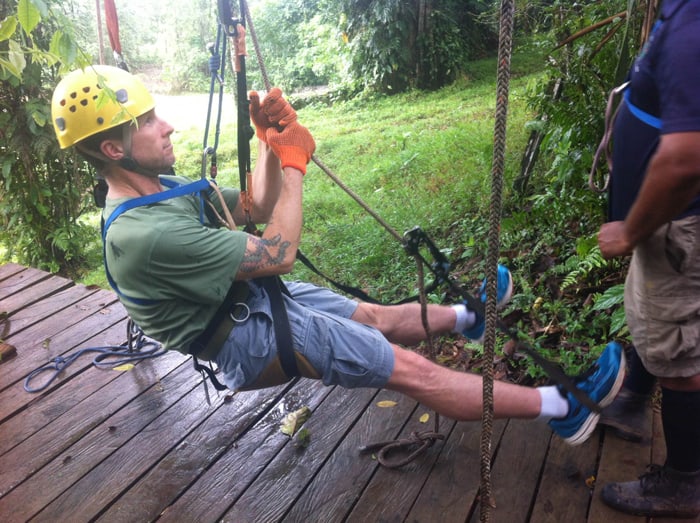
Jürgen is 50 years old but still sports a big shock of hair that seems to stand straight up from his head, like an ’80s rock star. He has the white skin to match his German heritage, but he is more Tico than gallo pinto, and he speaks pachuco with the best of them. His enthusiasm is intense, his passion is enormous and his grin is blinding.
And he’s the most dedicated environmentalist I’ve ever met.
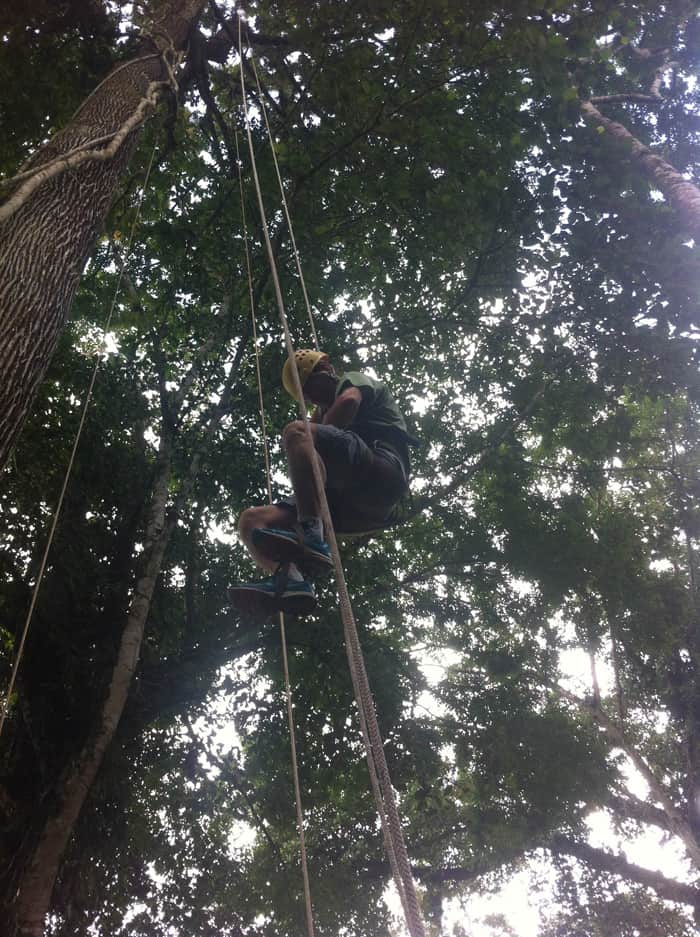
He charged into the river in his big van, then turned left and drove straight upriver in a place I wouldn’t have expected to be shallow. He said when the river is this low you don’t even have to switch into four-wheel-drive.
Later I remarked on the remoteness of this place, and Jürgen said something like, “Remote? It’s the belly button of the universe!”
But then he admitted that it’s a bit far away from things, and he said, “That’s all right. It weeds out the undesirables.”
Accent on the ‘eco’
Some ecolodges are more “eco” than others, and Selva Bananito Lodge & Preserve is a case in point.
Owned by Jürgen and his sisters Sofia and Karin, this is more of a forest that happens to have a lodge than a lodge that happens to have a forest.
Jürgen’s grandfather moved from Germany to Colombia in 1926, and Jürgen’s father, Rudi Stein, began farming there in the 1950s.
But in 1974, he bought a large tract of land on the upper Bananito River on Costa Rica’s Caribbean coast near Limón, intending to farm it and exploit its timber resources, which he proceeded to do with about one-third of the property.
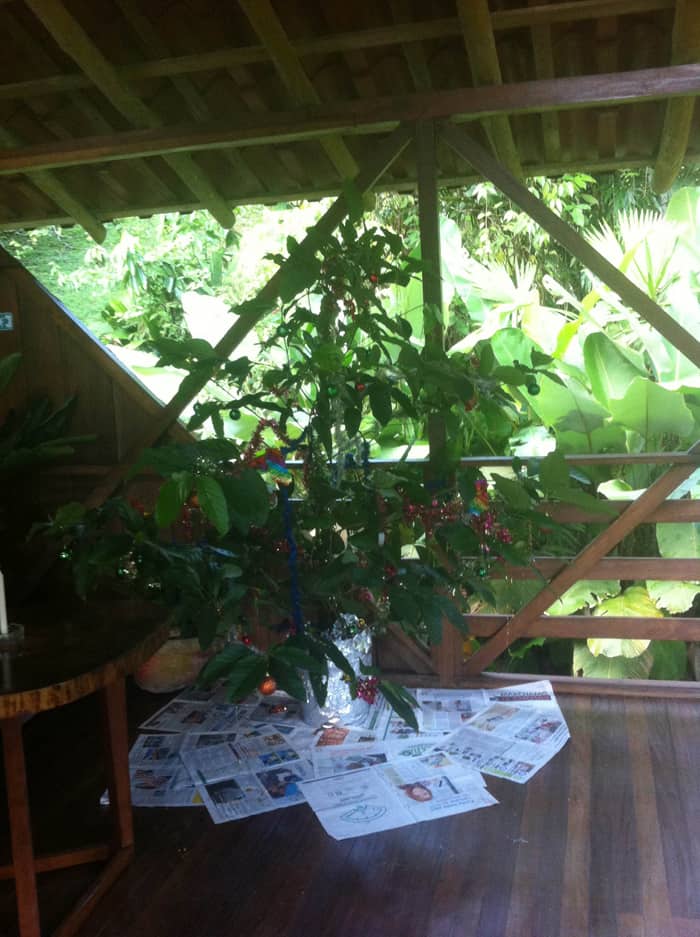
But the kids, who were small children when they moved here, went off and got liberal arts educations and developed a passion for environmental conservation. They came back, approached their father and asked him to make a change.
“In 1985 we asked our father to stop logging, and that is the turning point for this region,” Jürgen said in a presentation to guests before Christmas dinner. “He said, ‘OK, and now what are you going to do with this?’ He didn’t say it so nice; he was really angry. … He asked us, ‘What are you going to do with this land when I die?’”
The children’s appeal prevailed, and in 1994 the family decided to declare the unexploited two-thirds of the property (roughly 850 hectares, or 2,100 acres) a private biological reserve, and began building the lodge as an alternate source of income.
It’s no secret that some people have built hotels in the rain forest hoping to make a lot of money while paying lip service to conservation. But the younger Steins appear to have had the opposite motivation — wanting to do a lot of conservation while paying lip service to making money.
“The cost of conservation is not how much I pay my forest rangers or how hard it is and how you sacrifice and how stinky you are at the end of the day,” Jürgen said in his presentation to guests. “It’s how much money we did not harvest from the forest, like everybody else did.
“It’s the cost of opportunity — that’s the cost of conservation. In our case it’s millions of dollars of mahogany forest that we have not consumed to become rich.”
Rather than build in the thick of the forest, they built on land that was already being used as pasture. And out of a conviction that using timber efficiently reduces deforestation, they built 80 percent of their cabins out of “second class” hardwood discarded by loggers, which would ordinarily have gone to waste.
All cabins were built on Caribbean-style stilts, reducing interior moisture and improving views and ventilation. Traditional thatched roofs were not used because of threats to the suita palm from overuse, and because of the need to fumigate such roofs to keep bugs out.
On Dec. 24, 1995, Selva Bananito Lodge welcomed its first paying guests to its first cabins — thus the 20th anniversary we were celebrating this week.
I was shown to my “superior” cabin by a charming young German volunteer named Julia, and I asked if “superior” meant it was more elevated than the others or better than the others. She said, “Both.”
When she opened the door, I saw what she meant. It was a gorgeous room with two double beds draped in mosquito netting (complete with kissing Tico swan towels, with hibiscus flowers). It had louvered wooden window covers and matching fold-away doors over the big veranda, which had two hammocks, a soft chair and a sweeping view of pristine rain forest.
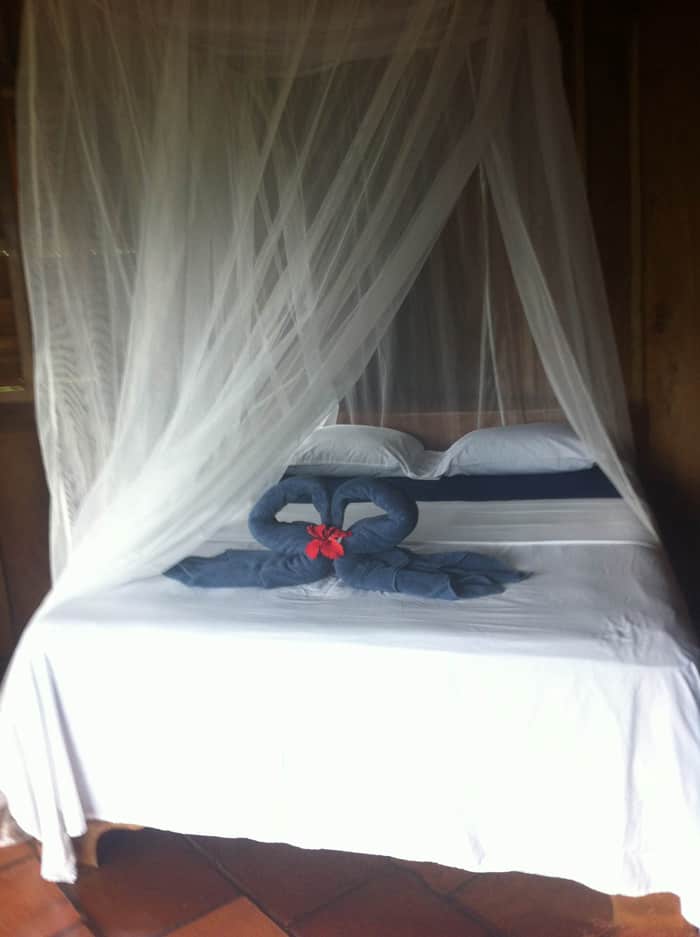
The floors were made of sturdy brown tile, the bathroom had a large hot-water shower, and the ceiling had several CDs hanging from strings, which Julia said were there to keep out bats.
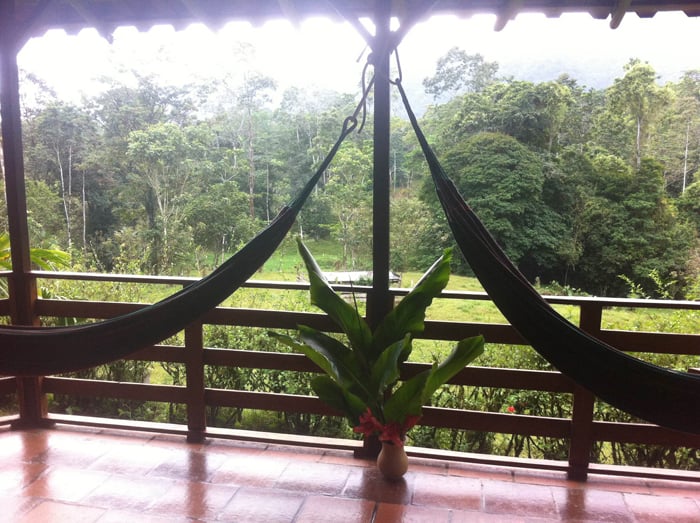
Though Selva Bananito had no electricity for years, today the rooms have small, solar-powered electric lights, kind of like strong flashlights, and my room had a brand-new ceiling fan that could be turned on if its power source was activated in another building. It did not have any power outlets, though I was told I could charge my phone or laptop in the office or the rancho where meals were served.
(The rancho still has no lights except candles, though it does have ceiling fans.)
Hot water is provided by a few solar heaters shared by several units, and its reliability varies. The septic system uses a special water-lily purification system, and fully biodegradable soap and shampoo is provided.
Selva Bananito Lodge has been awarded the maximum “5 Leaves” by Costa Rica’s Certification in Sustainable Tourism (CST) program. It gives 10 percent of its proceeds to the Limón Watershed Foundation, which was also founded by the Steins and is active in stream restoration, environmental education, regional planning and advocacy for an unbroken biological corridor from Mount Chirripó to the Caribbean.
The property borders the gigantic La Amistad International Park, which is probably the most unexplored and wildlife-rich region in Costa Rica. Selva Bananito’s private reserve is among the largest in the country, and is a critical water source for the capital of Costa Rica’s Caribbean coast.
In 1991, an earthquake caused a landslide that cut off Limón’s water supply from the Banano River, and in 1995 the city turned to the Bananito instead.
“We’re the most important direct watershed to the city of Limón, which 85,000 inhabitants drink,” Jürgen said.
Protecting that watershed is accomplished by saving trees, he said, because they store water and regulate water flow. Cut down all the trees and the water will blast its way downhill in a torrent of mud.
So if you ever feel inconvenienced here because you can’t charge your laptop or check the latest gossip on the Internet, remember that you’re helping to save the planet.
Sure, this is a hotel. But it’s more of a cause.
“We’re not about sustainable development,” Jürgen said. “We’re about sustainable conservation. It’s different, because development means we still cut down, we still try to expand, we still try to make money, and leave a little bit. Here it’s different. We need to leave a lot.”
The jungle on horseback
Jürgen invited me to go horseback riding, wanting me to really “experience” this place, and I readily agreed. So on the day after Christmas, Anette and I joined our guide Carlos Mairena, mounted our respective horses (Cacique, Canelo and Tequila) and took off.
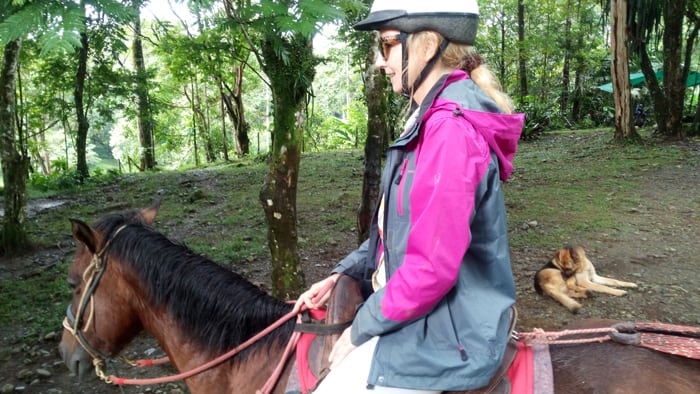
On a three-hour romp through green pastures, secondary forest and thick jungle, we were awed by the natural beauty all around us. The air was thick with toucans and oropendolas. Golden-tailed weaver birds flew back and forth between trees where they were weaving nests and trees where they were collecting the material.
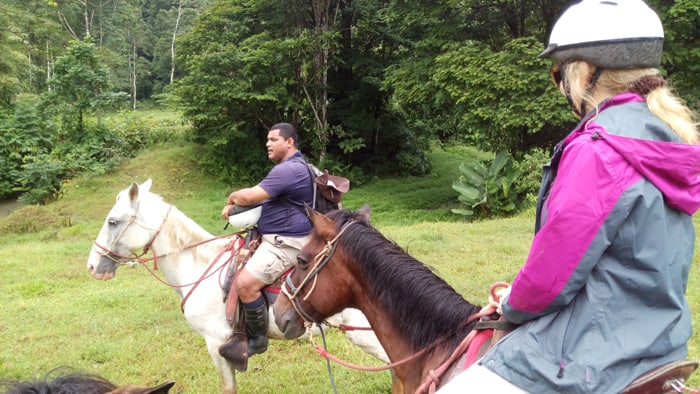
We saw two sloths and, the wildlife highlight of the day, a yellow eyelash palm pit-viper curled up like a looping ribbon on a tree trunk.
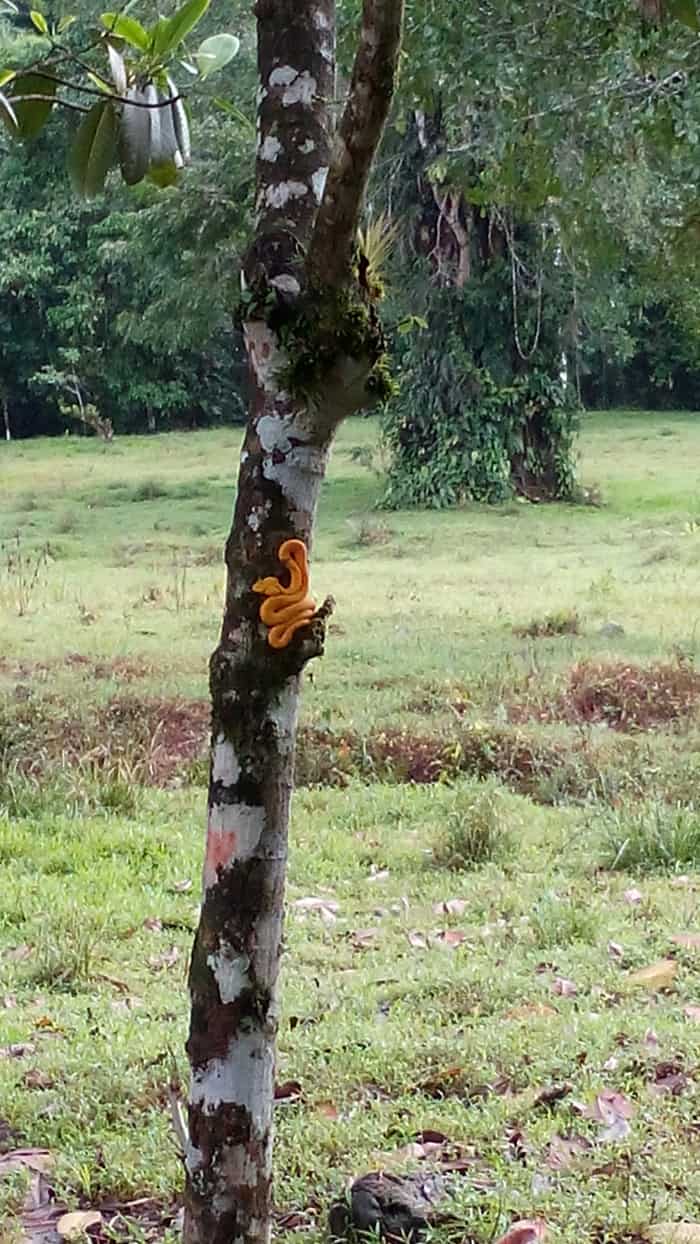
This being Costa Rica, our pretty nature tour came with a healthy dose of slightly scary adventure. After all the rain, the streams were full and the mud was thick, and there were places where the horses had to plunge down a steep bank into mud that rose to their bellies, then scramble to climb out again while we struggled to hang on.
After breaking us in on mostly easy-going flat pasture, Carlos led us onto a narrow, steep and extremely muddy trail in thick rain forest. He had warned us at the outset that when our horses walked under vegetation, we should duck our heads to avoid it rather than moving it aside with our hands.
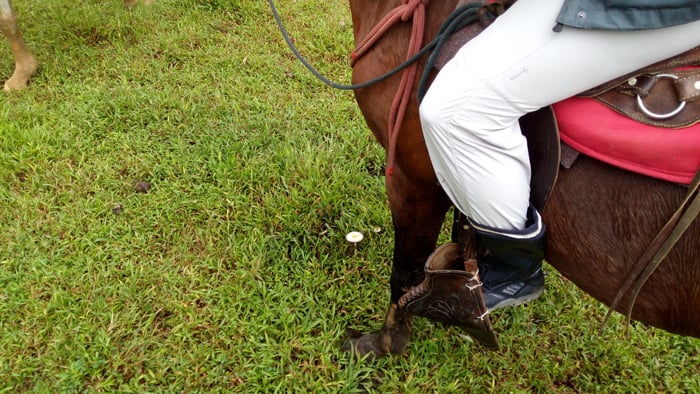
“Some of the branches have sharp little spines,” he said, “which can be a problem for you. But some of them also have wasps, which can be a problem for all of us.”
Now Carlos showed us a tree on the narrow jungle trail with big, sharp spines on its trunk that could cause nasty puncture wounds to the legs. He advised us to be on the lookout and force the horse to move away from the tree.
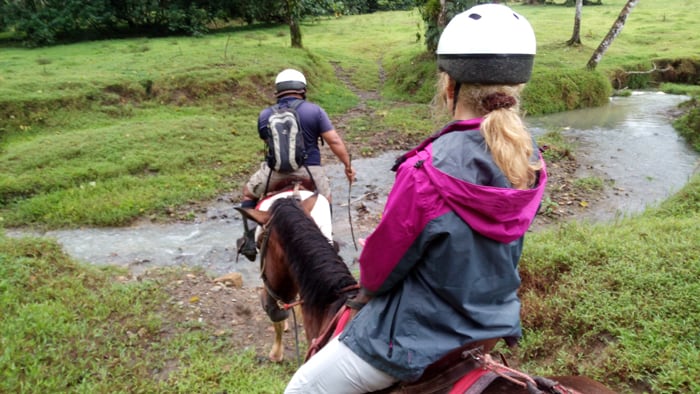
“The tree can’t move,” he said, “so it’s best to move the horse.”
After spotting the yellow viper, I didn’t need to be reminded of the threat of putting my hand on a branch where a perfectly camouflaged snake was resting.
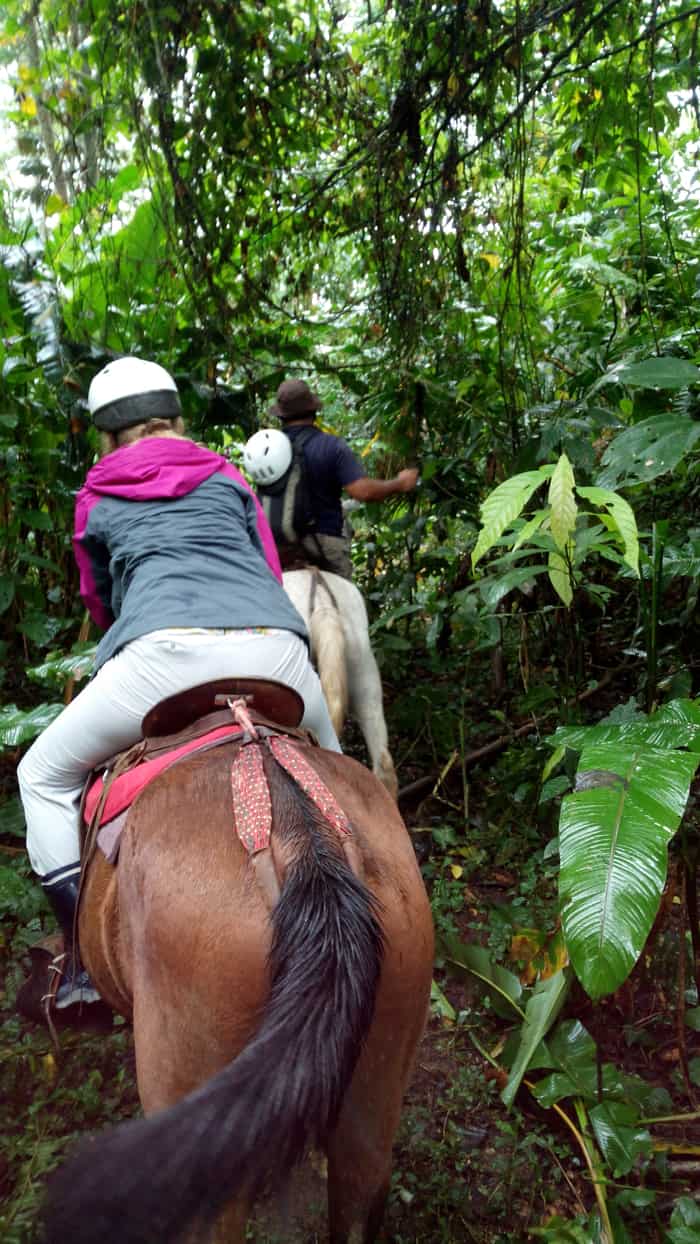
Carlos didn’t mention the danger of snakes — or, initially, the fact that these woods were thick with big spiders, some of which had spun webs across our trail.
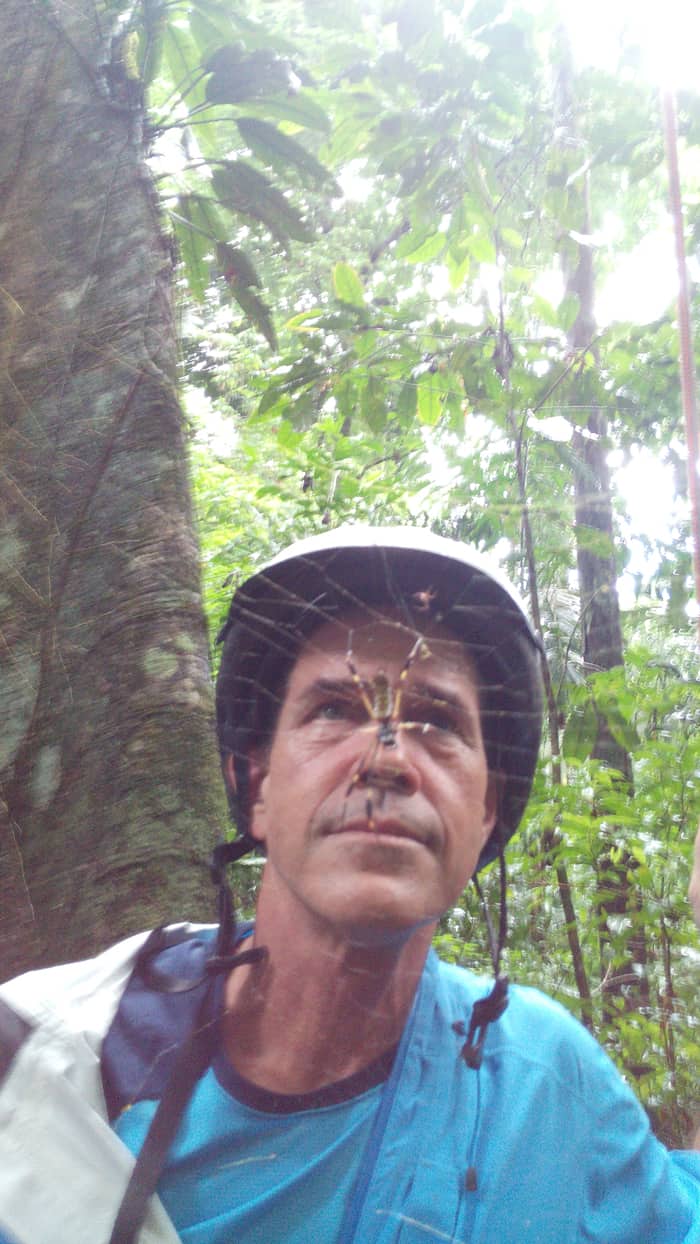
He did tell us to lean forward when climbing a steep hill and lean back when going down one.
At one point he said to Anette, “Lean back to avoid that big spider web.”
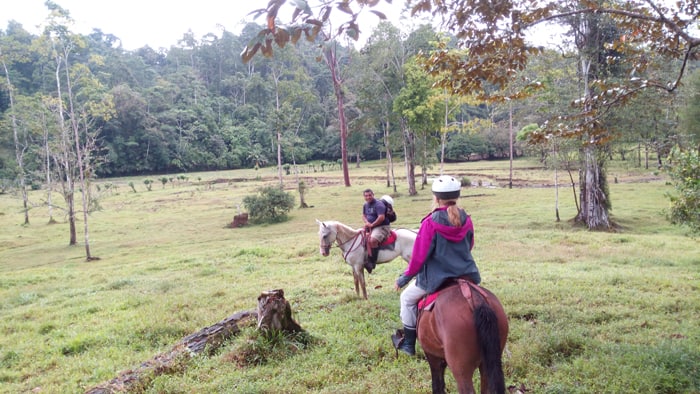
“Where is the spider web?” Anette asked with some concern, leaning as far back as she could.
“It’s right over your head,” I said. “You’re good.”
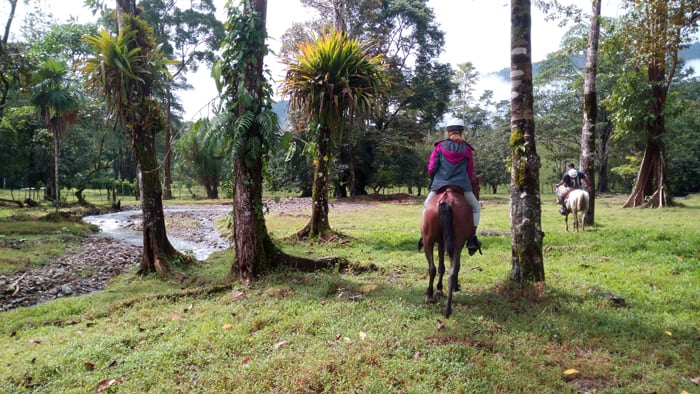
My moment of fright came on a steep, muddy downhill when Canelo balked, not liking the looks of the angle, and I leaned back and kissed the air to urge him on. He plunged all at once and lurched to a stop, and I felt myself flying forward, in danger of going airborne.
But I held on. Anette said the exact same thing happened to her.
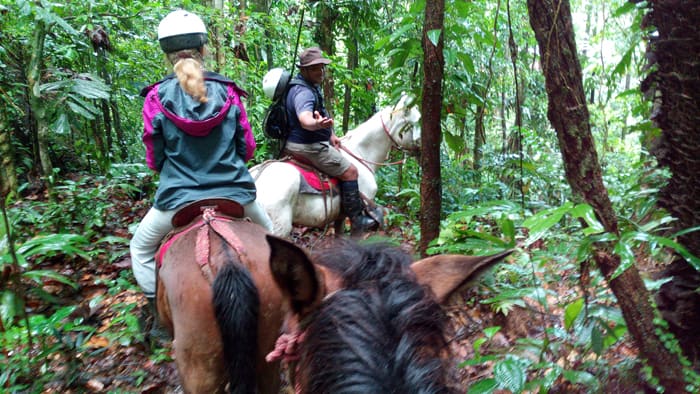
They say it’s all fun and games until somebody gets hurt. So I guess it follows that if nobody got hurt, it was just all fun and games.
Community organizing in the rain forest
After a lunch of arroz con pollo, it was go time for Jürgen’s masterstroke of theater, community relations, advocacy, education plus a big-time party — the event he had invited me here to cover.
Jürgen’s sister Sofia showed up from San José, and I watched as she charmed three invited Fuerza Pública police officers from Limón (a comandante, a capitán and a chofer) into taking off their boots before entering the rancho, making a joke about how we’re all equal here, so if they had holes in their socks, we would find out about it. The cooks, overhearing this, burst into laughter at her boldness.
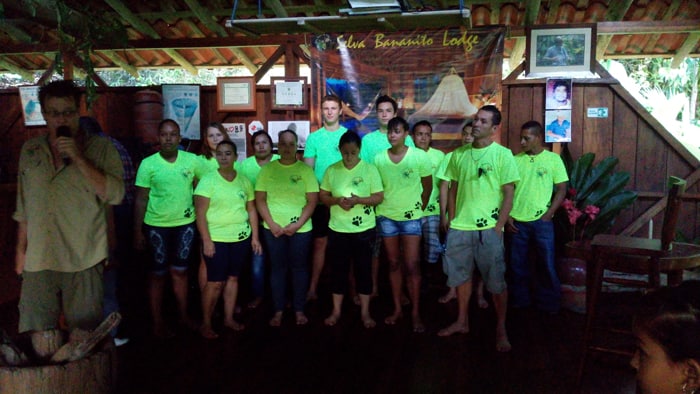
I sat with the Steins as they explained to the cops their challenges here with illegal hunters, and invited them to train their officers here in anti-poaching techniques. The idea, Jürgen told me, is pretty simple: Bring in a bunch of cops with big guns for training, let the word spread, and see how many poachers show up after that.
Next thing you know, a stream of perhaps 50 Ticos from the neighboring town of Bananito appeared at the rancho, having been driven across the river in a half-dozen vans provided by the lodge. I was amazed to see this stream of humanity in such a hard-to-get-to place, and I knew it was the direct result of Jürgen’s personal outreach to his neighbors.
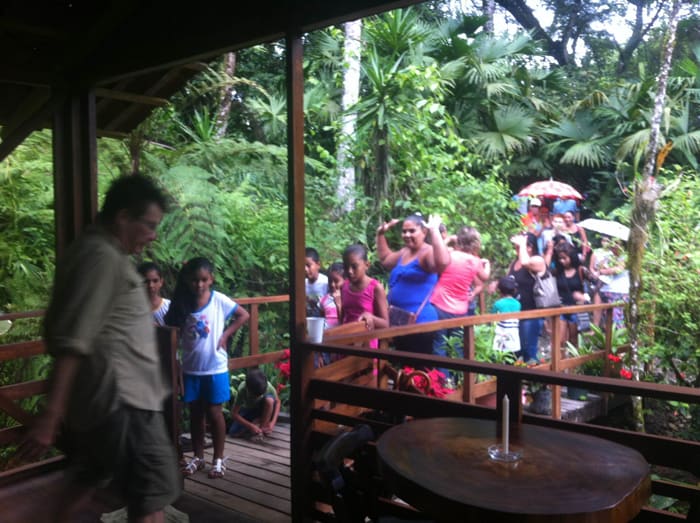
There was also a calypso band, old friends of Jürgen’s, to pump up a dance floor with Afro-Caribbean rhythms and add to the happy ethnic mix of Latino Ticos and pale foreigners.
Jürgen and the band opened with an a cappella version of the Costa Rica national anthem, followed by the Lord’s Prayer in Spanish, and then in German.
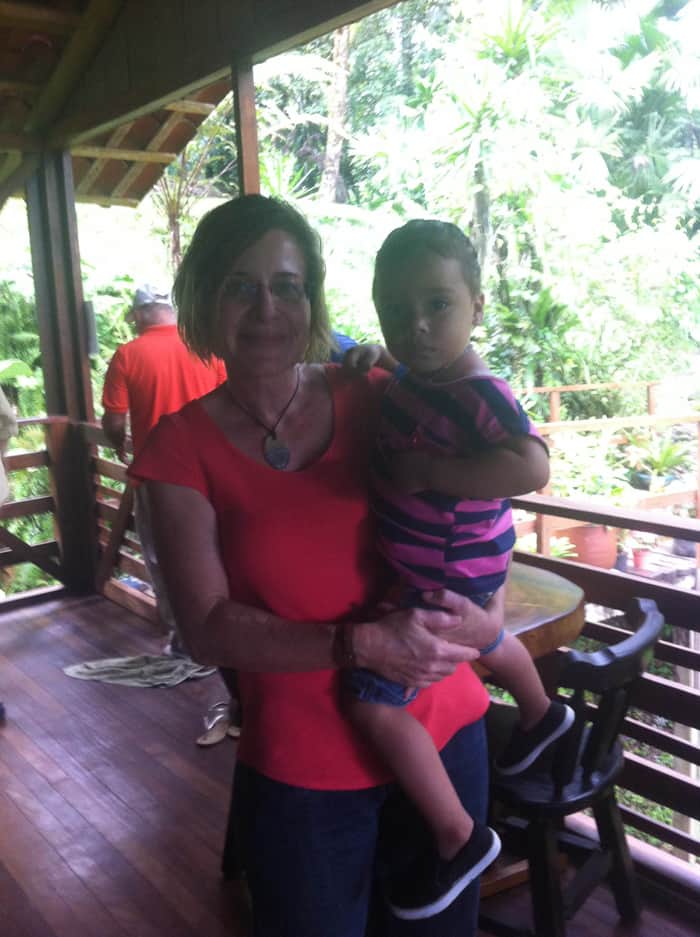
Jürgen offered a remembrance of those who are no longer with us, including his recently departed father, who in many ways made all of this possible. And in commemoration of these souls, Sofia opened a big mesh enclosure to liberate blue morpho butterflies.
Then the band cranked up the music, and Jürgen started dancing with such abandon that he banished all timidity from the rest of us.
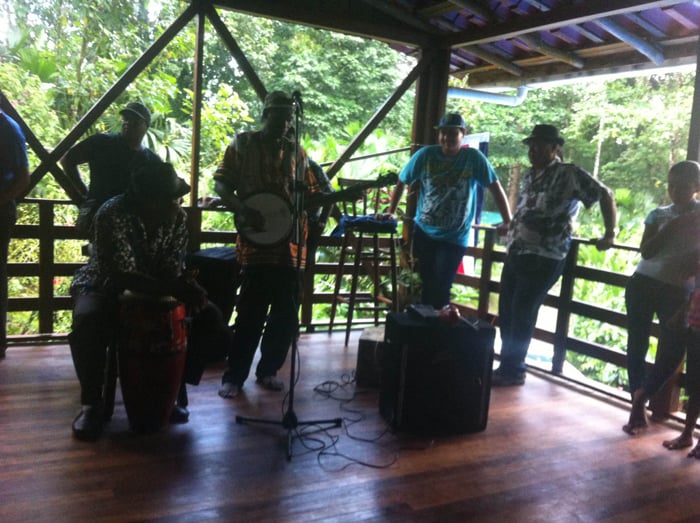
Traditional Christmas tamales were served, to be followed later by a plato fuerte of chicharrones, yucca and salad.
But in between these courses, Jürgen took the microphone, put on his “prophet of doom” hat and gave a condensed version of the talk he had given guests the previous day, though this time in Spanish.
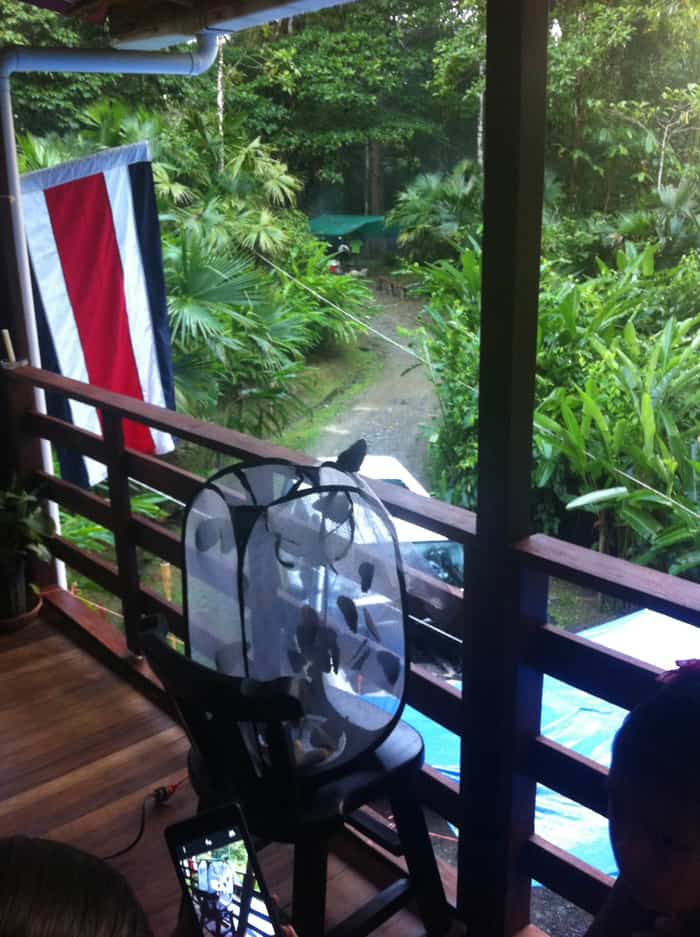
“For 20 years I’ve been talking about what the World Health Organization was predicting: climate change,” he said. “Millions of refugees, not only political refugees but environmental refugees. That wave hasn’t come yet, but it’s coming like a train. It’s coming as surely as the 20 years we celebrate today.”
He warned that the changes are going to be drastic, and that the children sitting on the floor in front of him would inherit a far different world than we adults experienced as children.
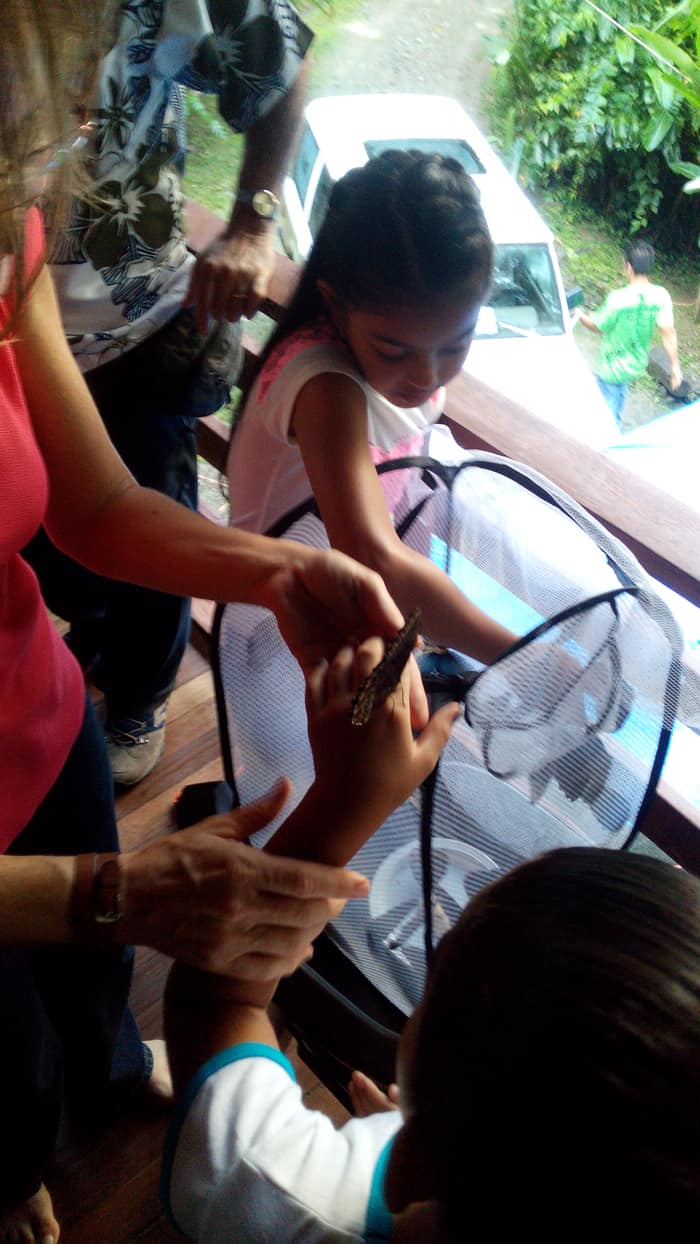
“Who remembers 2012?” he asked his guests. “Here it didn’t rain for seven months — that river was dry. … Who remembers three months ago? Here we got 10 days’ worth of rain in in seven hours. And that’s happening all over the world. …
“There are going to be worse floods and there are going to be worse droughts. And millions of people are going to lose their homes because the sea is going to rise much more quickly.”
The remedies, he said, were to save the trees that sequester carbon, to reduce consumption of fossil fuels, to adopt renewable sources of energy, and to do all of this while giving people who live in the forest an honorable way to make a living without destroying the environment that is there to sustain them.
Jürgen closed with an astonishing video from cameras on his property showing jaguars, pumas, ocelots, margay cats, peccaries, agoutis and coatimundis prowling the forest.
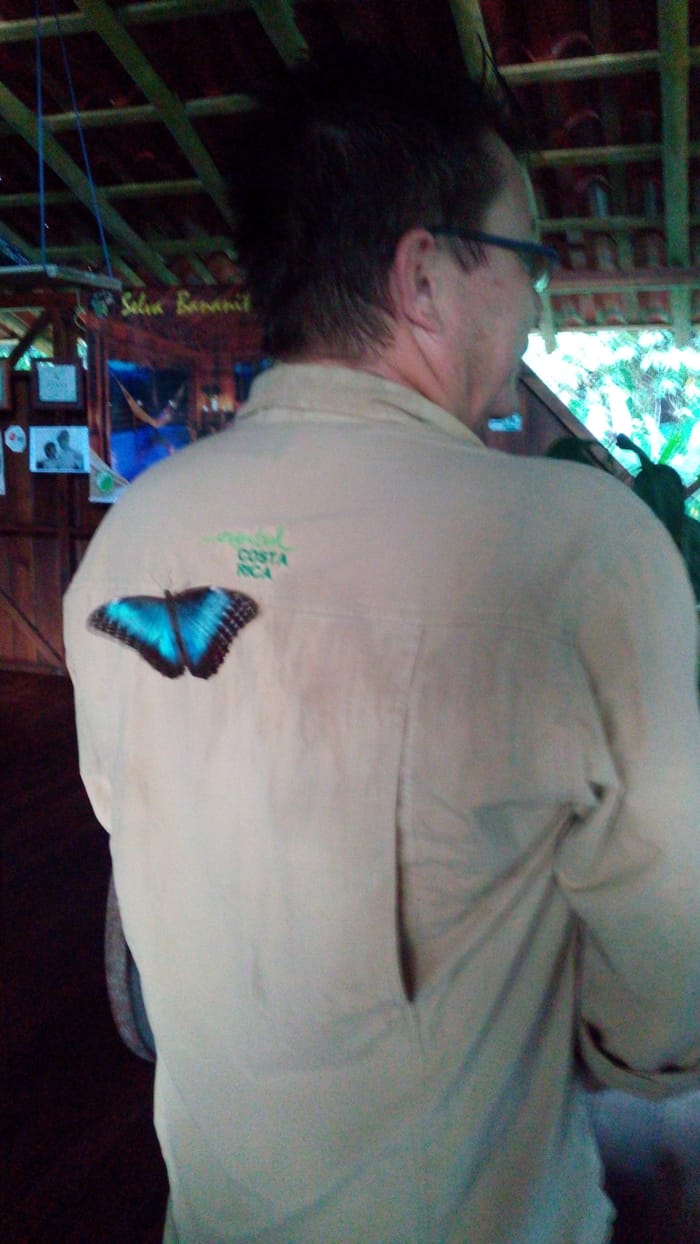
And then it was time for more calypso music, more food and the daunting logistics of transporting 50 people across the Río Bananito in the dark.
Before I left the next day, Jürgen said to me, “Karl, when you leave this place you will become part of this forest. It’s your, not only work, but your responsibility to share the message, because this is what we do, we plant seeds for others to inspire.
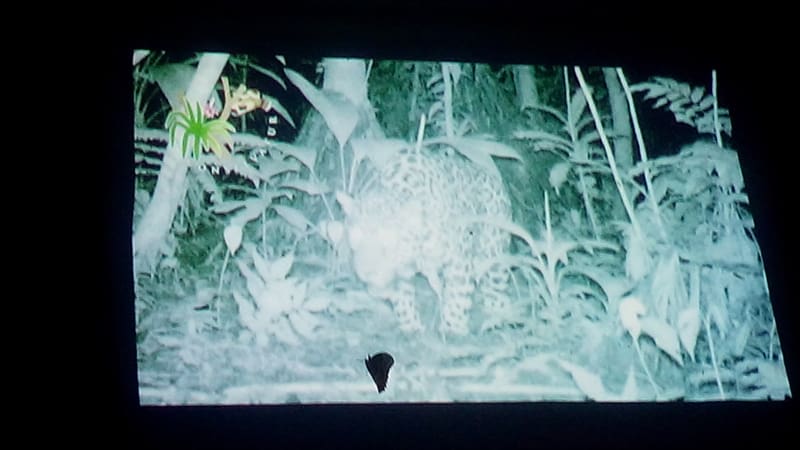
“One time someone said, ‘Do you have any idea how many people you have touched in your life with your passion for this?’
“And if of 100, two might change their habits and move in a better direction, then that was the whole purpose of this.”
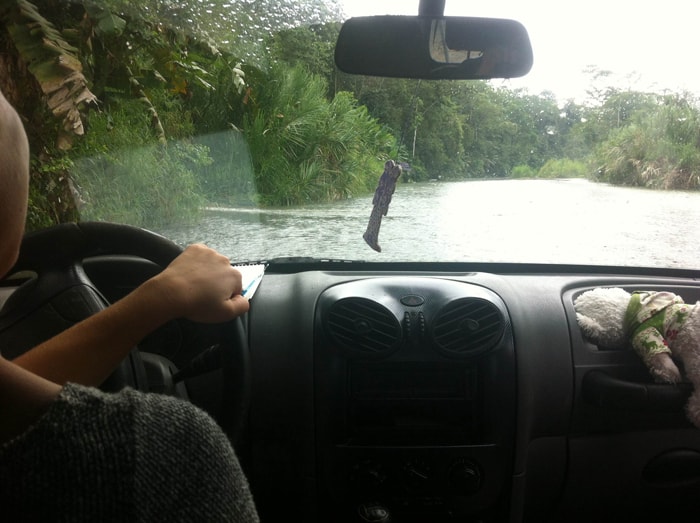
IF YOU GO
Getting there: Do not follow directions on the Waze app, as they are totally wrong. Detailed directions are printed on the Selva Bananito website. Four-wheel drive is essential for driving to the lodge, though the faint of car can arrange for pickup in Bananito.
Rates: $160–$180 per person per night, double occupancy, if staying three nights; slightly more for shorter stays. Rates include all meals, all taxes, one tour or other activity daily, and transportation to and from Bananito.
For more info: http://www.selvabananito.com
Contact: Call 2253-8118, or email reservas@selvabananito.com.
Contact Karl Kahler at kkahler@ticotimes.net.

